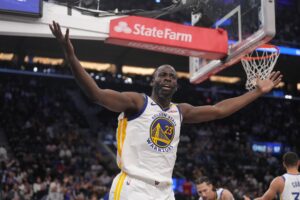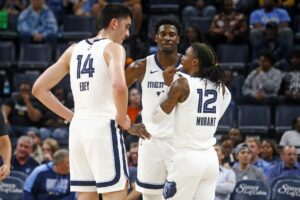The Kentucky Wildcats have allowed at least 85 points in two of their first three conference games. This has never happened under John Calipari, and the first time it’s happened since 1990, when the Cats were under NCAA probation. Kentucky’s defense currently ranks 55th in defensive efficiency on Kenpom, their lowest since 2013. While the offense is among the best in the country, Kentucky’s defense could be holding them back.
The Explanation for the Kentucky Wildcats’ Defensive Woes
Kentucky’s youth gives reason to believe they can become a good defensive team. However, the reality of the situation is that they’re struggling. On a per-game basis, they give up a lot of points, but they play so fast that’s bound to happen. On a per-possession basis, the Cats rank 96th in opponent effective field goal percentage on Kenpom. They’re also 132nd in opponent two-point percentage.
Kentucky’s biggest problem, like most teams that struggle defensively, is their ability to guard the three-ball. Kentucky’s defense is a whopping 321st in opponent three-pointers made per game. While they’re 350th in opponent three-pointers attempted, there’s a reason teams shoot that many. If teams are shooting that many threes despite not having a center half the season, it’s not a coincidence, it’s a pattern. The Cats rank 82nd in three-point defense. When teams shoot that many threes against you, that has a lot bigger of an effect than 82nd.
Compared to what most bracketologists think are the four one-seeds at the moment, Kentucky is a mixed bag in terms of how their three-point defense stacks up. Houston ranks sixth, Purdue ranks 58th, Kansas is 100th, and UConn is 249th. While on paper Kansas and UConn are struggling a lot more from three, UConn ranks 40th in defensive efficiency, while Kansas is up at 12th. The difference is that Kentucky is 132nd in two-point defense, UConn is eighth, and Kansas is 22nd.
Fixing the Cats’ Defense
The good news for the Cats is they currently rank just 22nd in personal fouls per defensive possession. While they struggled to keep Texas A&M off the line, overall the fouling isn’t a huge issue. They also rank 11th in block percentage. While they’ve been inconsistent in guarding the rim, they’ve certainly shown the potential to be an elite rim-protecting team.
The other thing Kentucky has going for them is their youth. Reed Sheppard ranks 12th in the country in steal percentage, while Robert Dillingham clocks in at 140th. The foundation is there. The on-ball defense has to improve. Opponents were shooting 48 percent with D.J. Wagner as the primary defender, and 46.3 percent with Robert Dillingham as the primary defender. This was before the dominant display from Tyrece Radford and Wade Taylor. The guards have to get better. The two-point defense is so rough. Stopping the ball is crucial, and that’s something that Kentucky’s defense is struggling with right now.






